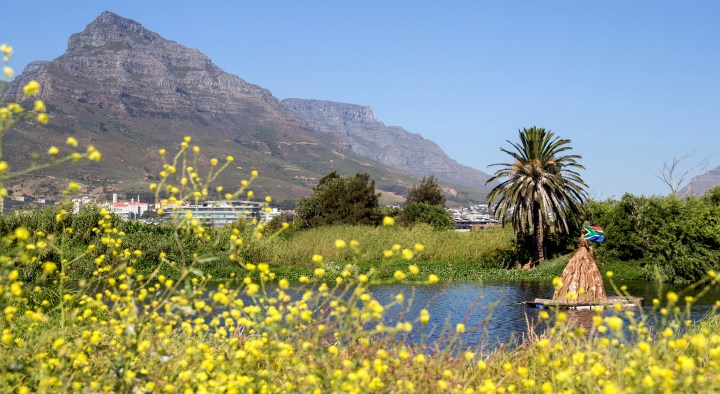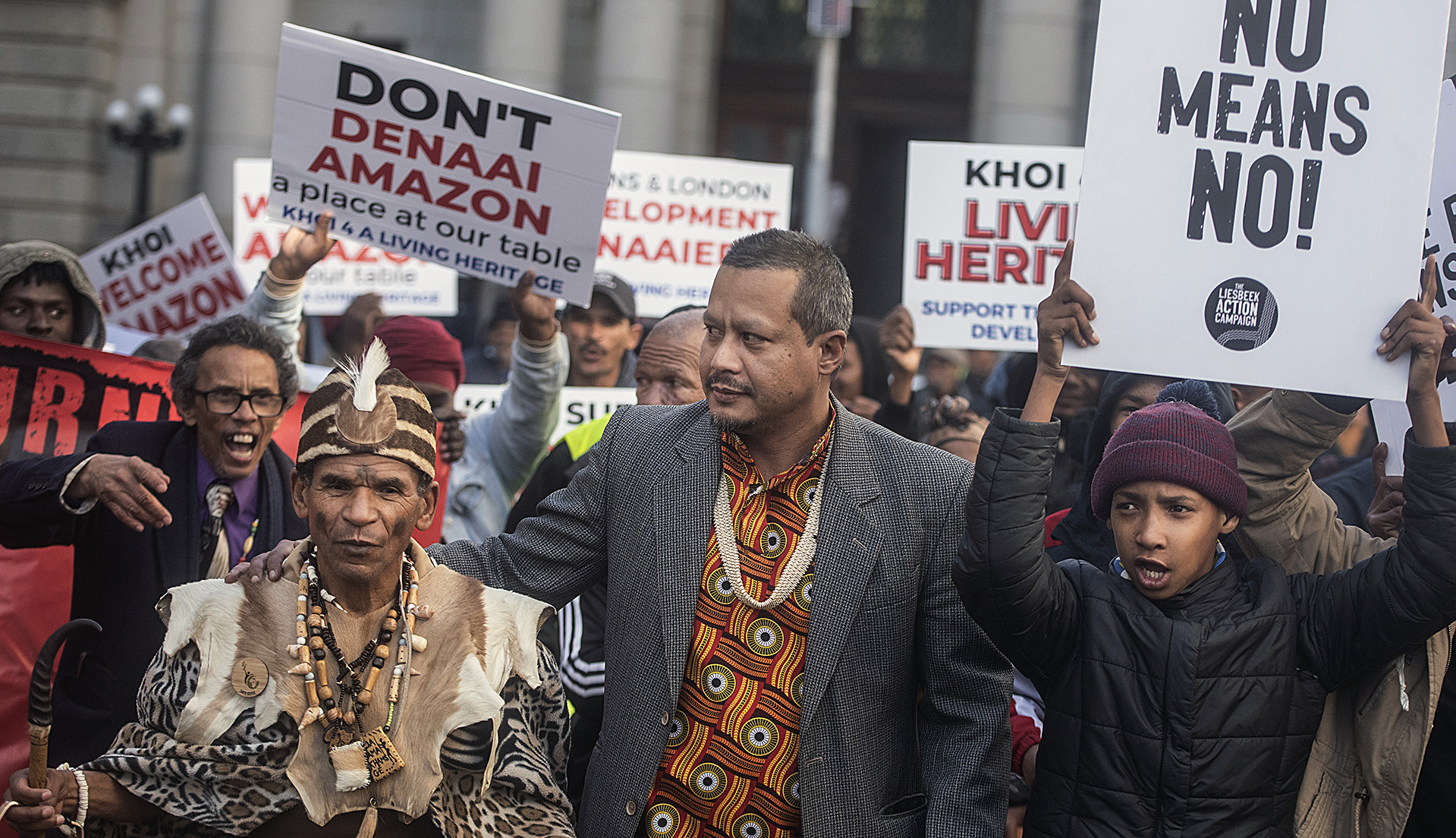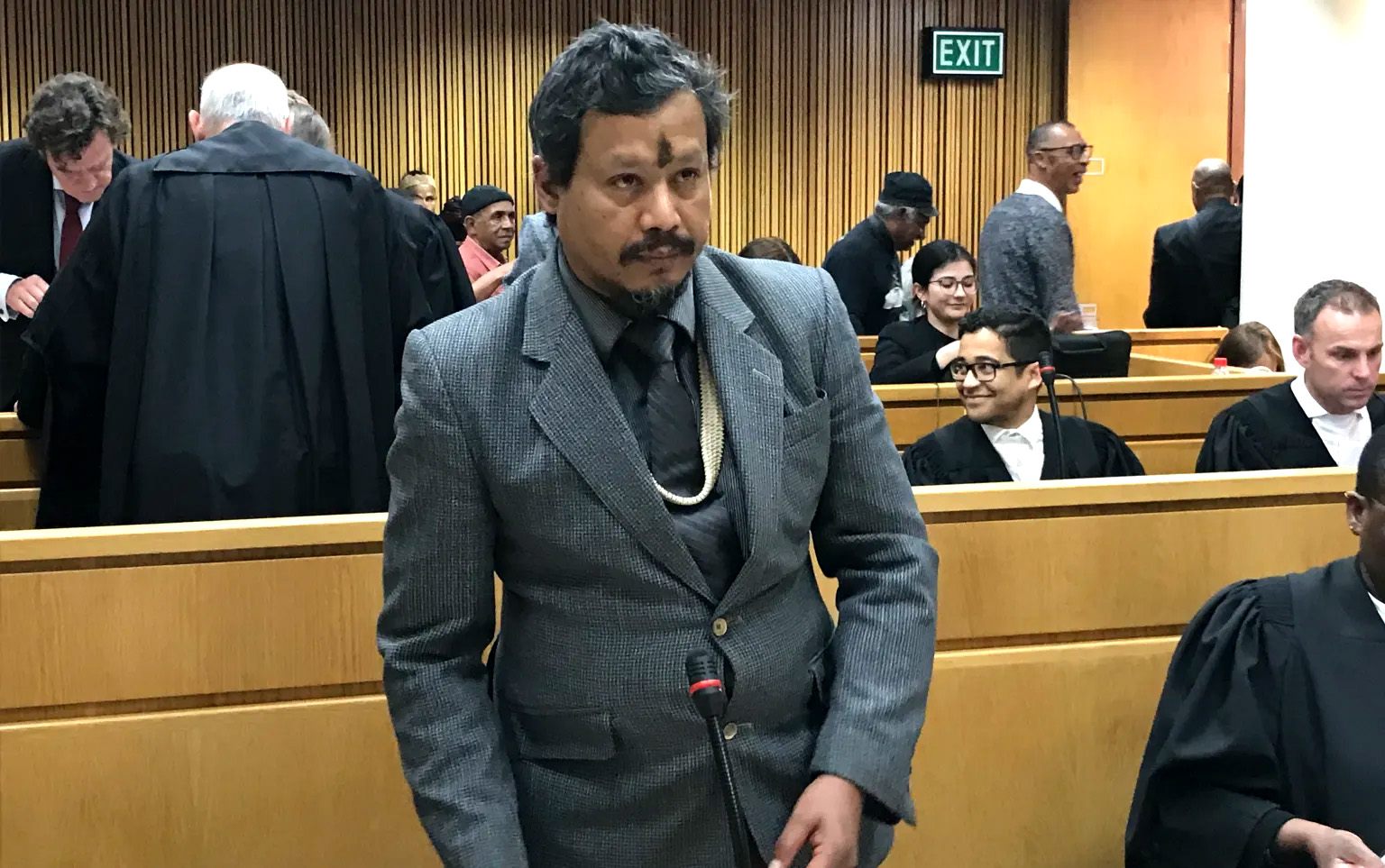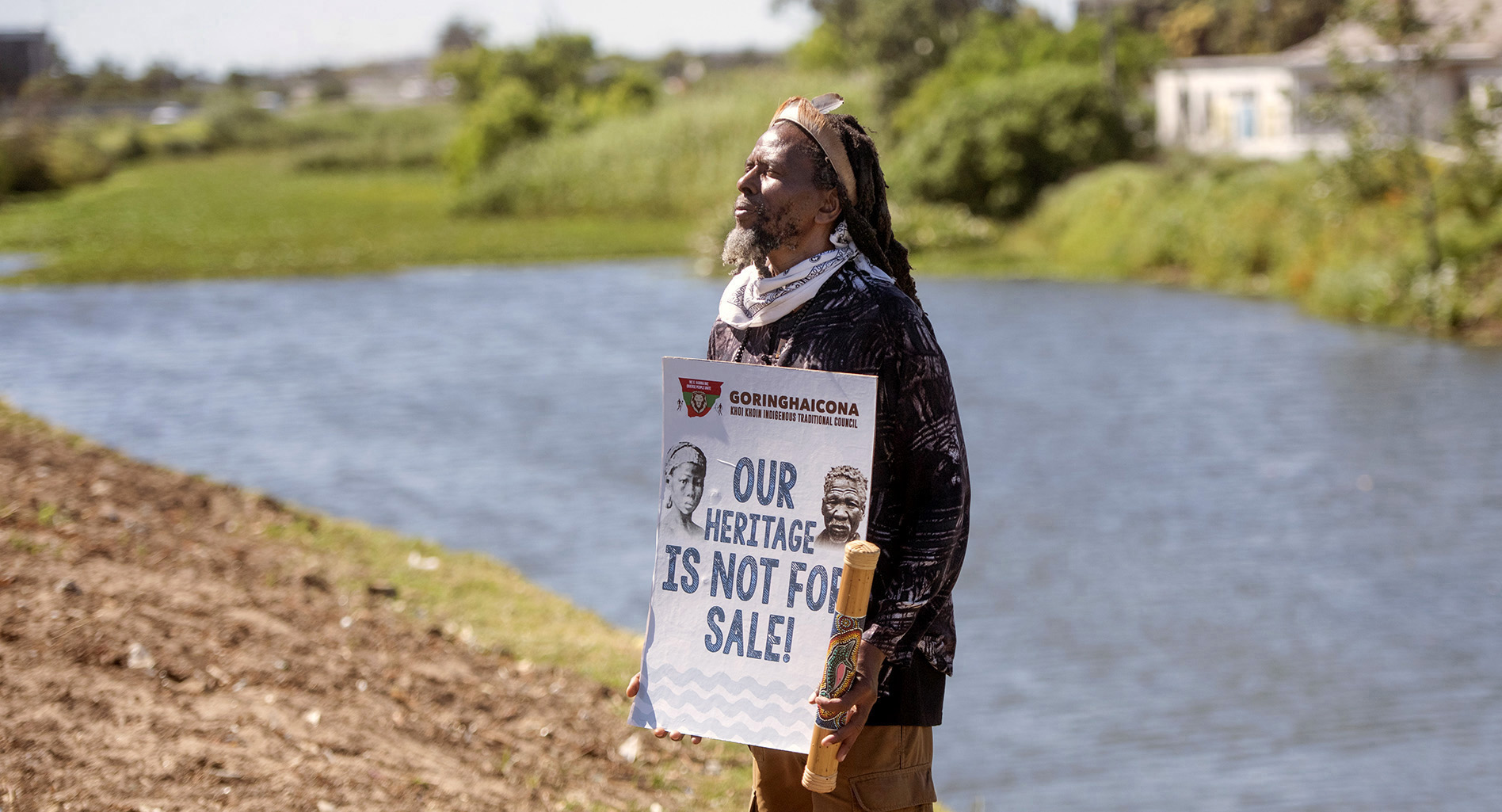BATTLE FOR HERITAGE OP-ED
Power, money and PR — the River Club development’s public costs and private benefits

On balance, considering the public costs and alleged public benefits, it is clear that the costs have been understated and the benefits overstated, in the public sphere where the developer, the City and the province clearly are aligned and have control over the dominant narrative, but more importantly in the courts, where these costs and benefits have yet to be tested in a judicial review.
Recent reports and opinion pieces reveal that four whistle-blowers have come forward, detailing in sworn affidavits how they worked together with representatives of the Liesbeek Leisure Properties Trust (LLPT), developers of the contentious R4.5-billion River Club development in Cape Town, to hijack the Goringhaicona Khoi Khoin Indigenous Traditional Council (GKKITC), which has been opposing the development since 2017 and challenging its approval on heritage, environmental and procedural grounds in the Western Cape High Court.
They explain how this fraud was perpetrated with the assistance of an LLPT-affiliated lawyer, facilitating perjury and challenging the legitimacy of the GKKITC’s leadership. This resulted in a November 2022 judgment against GKKITC high commissioner Tauriq Jenkins, effectively removing one of the two parties opposing the development, the other being the Observatory Civic Association (OCA). Jenkins was unable to afford legal representation at the time, and was not given the opportunity by the court to counter these claims. Jenkins has also been subject to smears online and in the press, as well as threats and physical harassment.
In May 2023, because this fraud had not yet been exposed, the Supreme Court of Appeal (SCA) refused an OCA appeal against a high court order upholding an appeal of the March 2022 interdict against the development. Due to high costs orders against it, the OCA then chose to settle with the LLPT, Western Cape government and the City of Cape Town. The settlement required the OCA to withdraw from the planned high court review of the development approvals, in exchange for waiving most of the cost orders.
The whistle-blowers’ affidavits are insightful on a number of levels.
They confirm Jenkins’s legitimacy as GKKITC leader and detail how the LLPT’s Jody Aufrichtig and his associate, Mark Fyfe, allegedly conspired with former GKKITC member Ebrahim Abrahams to challenge Jenkins’s leadership of the GKKITC. Abrahams was introduced to them by Tania Kleinhans-Cedras of the First Nations Collective (FNC), the indigenous group set to benefit from the River Club development.

Chief Aùtshumao! Francisco MacKenzie, chairperson of the Western Cape Legislative KhoiSan Council, and Tauriq Jenkins, high commissioner of the Goringhaicona Khoi Khoin Indigenous Traditional Council, outside the Cape Town High Court with First Nation Collective supporters and Chief Garu Zenzile Khoisan (on behalf of the Gorinhaiqua Cultural Council) in background on Tuesday, 12 July 2022. (Photo: Brenton Geach)
According to Abrahams’s affidavit, he was only a member of the GKKITC for a few months, and in March 2022 left the GKKITC and founded a new group called the Krotoa of the Goringhaicona. Following a meeting of the Krotoa group, attorney Tim Dunn (who attended) drafted a resolution and affidavits, which were signed by leaders of the group, supporting the River Club development and revoking Jenkins’s leadership of the GKKITC, despite no GKKITC members being present.
Leaders of the Krotoa group fraudulently pretended to be leaders of the GKKITC in these documents drawn up to appear as real GKKITC documents, which were then presented to the Western Cape High Court in an application to declare Jenkins as a fraudulent and illegitimate leader of the GKKITC. These, along with court testimony by two Krotoa leaders, resulted in the 2022 judgment against Jenkins.
The whistle-blowers’ affidavits claim that in return for taking Jenkins down they were each promised R2-million and a house. Abrahams states that he has faced threats as a result of the affidavit. While he admits that he initially assisted the LLPT to target Jenkins, he states that he was later fed up with the “lies” being told about the GKKITC and decided to come forward.
What is also revealing is how this alleged conspiracy speaks to the power relations at play in the River Club development and in broader society, and the history of these relations.
Abrahams states that all of the members of the Krotoa group were in financial distress, and thus were vulnerable and “easy prey for the developers”. As Senior Chief Faraah September of the GKKITC notes: “It’s sad that people’s vulnerability could be used as a divide-and-rule tactic.” However, the manipulation (and oppression) of the descendants of indigenous Khoi and San, part of the broader diverse identity encompassed by the colonial and apartheid term “coloured” – which includes African, Asian and European ancestry, and slavery – has a long history.
History of manipulation and oppression
The River Club site and the broader floodplain (known as the Two Rivers Urban Park) were important in the first resistance against colonialism, where it is broadly acknowledged that the Khoi fought the Portuguese in 1510 as part of the running Battle of Salt River, in response to a Portuguese cattle and kidnapping raid (with Viceroy Francisco De Almeida killed and the Portuguese abandoning colonial ambitions at the Cape).
The floodplain was also where the First Khoi-Dutch War (1659-1660) was sparked due to conflicts over access to traditional grazing areas, restricted through force by Dutch colonisers. The former main crossing point for indigenous herders and their cattle was close to the confluence, and the line of forts connected by a log fence erected on the eastern side of the Liesbeek River by Jan van Riebeeck to restrict access to grazing land ran through the River Club site.
The land became a frontier of displacement, which was extended over centuries and later codified into law through apartheid.
Indigenous South Africans faced colonial exploitation, genocide, forced removals and epistemicide (the silencing, annihilation or devaluing of indigenous knowledge systems) for more than 340 years. Despite some progress since 1994, structural inequality based on gender, race, class, disability and ethnicity persists in South Africa and particularly in Cape Town, widely considered to be South Africa’s most unequal city.
The River Club development has been planned, approved and is being constructed in the context of this history and inequality, and associated unequal power, economic and social relations.
In his book, A House Divided: Battle for the Mother City (2019), Crispian Olver, an academic and former director-general in the Department of Environmental Affairs and Tourism, specifically mentions the problematic drafting of the city’s Two Rivers Local Spatial Development Framework, which covers the area in which the River Club is located. The book explores how the city has been run, and focuses on the cosy relationship between local politicians and property developers, which has been corroborated by Brett Heron, a former mayoral committee member for transport and urban development.
In this unequal context, what are the real public costs and benefits of the River Club development?

Tauriq Jenkins represented himself in the Cape High Court. (Photo: Steve Kretzmann)
A public cost-benefit analysis – debunking the talking points
The developer, the City of Cape Town and the Western Cape government have on multiple occasions made claims about the River Club development’s alleged public benefits, which are then uncritically repeated by the media, conditioning public opinion in support of the development. However, these claims have not been interrogated, and should therefore not be taken at face value.
We analyse five of them below and find them all wanting:
‘The development will assist in preserving and protecting First Nations heritage and establishes heritage infrastructure in partnership with First Nations groups’
While the developer’s application process began in 2016, indigenous Khoi leaders were not consulted until the developer was ordered to do so by Heritage Western Cape (HWC) in 2019. The developer, with the support of the First Nations Collective which formed around this time (and which allegedly only represents a minority of indigenous Khoi and San groups), intends to dedicate a small corner of the extensive development to indigenous heritage.
The (white) developer claims to speak on behalf of indigenous concerns and claims the development will “remove the cycle of invisibility that has clouded the First Nations heritage for many years”, despite HWC rejecting the developer’s Heritage Impact Assessment for not taking full cognisance of the impact of the development on indigenous heritage.
HWC has noted the indigenous living heritage significance of the site. The continuing living heritage and spiritual significance of a site or landscape lies precisely in its preservation in as natural a state as possible, and its continued use for spiritual and other cultural purposes (see the 1994 Nara Document on Authenticity, the 2003 Unesco Convention for the Safeguarding of the Intangible Cultural Heritage, and the 2009 National Policy on South African Living Heritage).
Indigenous Khoi still acknowledge the site’s natural, spiritual and cultural value (as noted in a 2017 Heritage Report commissioned by the Western Cape Department of Transport and Public Works). Until it was closed off by the developers, indigenous ceremonies were still being performed on the site.
HWC issued a provisional protection order over the site in April 2018. In December 2019, more than 20 civic organisations and various paramount chiefs and indigenous groups announced their combined application for the site’s provincial heritage status, while the national government has identified the area as part of the Khoisan Legacy Project and the National Liberation Heritage Route.
‘Rehabilitating a portion of the Liesbeek River and creating high-quality green open space’
The developer’s many proposed flood-control measures are necessary due to the conversion of a predominantly open space in a floodplain into a highly bulked and massed development that covers about 60% of the site. Only 13% of the site will be retained in a semi-natural state. The City of Cape Town’s Environmental Management Department, in its appeal against the development’s environmental authorisation, noted that “the decision does not give due consideration to climate change impacts and resilience, and fails to apply the precautionary principle”.
The developer has filled in the original natural course of the Liesbeek River, which according to the their own Biodiversity Impact Assessment provides a habitat for important bird species and provides breeding areas to the endangered Western leopard toad (see this affidavit in Case 12994/21), and turned it into a stormwater swale, which is essentially a grassed, open stormwater ditch. This proposal was one of the grounds for the City’s Environmental Management Department appeal.
What the developer claims to be a portion of the Liesbeek River that they are rehabilitating, is in fact a major diversion to the original river course in the form of a concrete canal that was built in the 1960s between the former Liesbeek lake (south of the River Club) and the Black River. The developer claims that they will clean and maintain “their” stretch of the river. This is a Sisyphean task as this is a small part of the river course and its catchment, over which the developer has no control.

A protester during the Liesbeek Action Campaign against the Amazon River Club development on 12 November 2021. (Photo: Gallo Images / Brenton Geach)
‘Creating more than 5,200 construction jobs and approximately 19,000 employment opportunities, and delivering new residential accommodation, including affordable housing’
A consultant from SRK Consulting, which undertook the development’s socioeconomic impact assessment (SIA) in 2019, noted in a 2022 affidavit (Case 12994/21) that figures for the number of direct jobs created were provided by the project team and LLPT in 2019.
However, the developer and the City of Cape Town continue to punt these outdated estimations that clearly do not take into consideration the continuing social and economic impacts of the Covid-19 pandemic and the long-term changes they have wrought; load shedding and infrastructure constraints; and low economic growth – all affecting the demand for office space, and the affordability of and ability to pay for housing. Thus, it is also not clear whether all proposed phases of the development will materialise, further pouring cold water on the estimations.
While the SRK consultant noted LLPT’s estimate that about 860 people will be directly employed at the River Club development (i.e. excluding those employed by tenants), it is unclear what the figure of “approximately 19,000 employment opportunities” is based on.
Additionally, these and other claimed benefits should be interrogated in light of concerns around the many assumptions and rigour of socioeconomic assessments.
Construction jobs are by their nature low paying and temporary. Most of the Amazon workers would be existing employees moved from their current city-centre offices. While other office workers would be accommodated in the development, most employees in the office and retail components will most likely be lower-income workers. They would still spend up to 40% of their income on travelling long distances to the site.
The affordable housing promised is 20% of the 20% of the development’s floor area allocated to residential use, thus only 4% of total floor area. Raising the majority of the River Club site more than 6m above natural ground level to (supposedly) avoid heavy flooding, results in a high development cost. To maintain financial feasibility, this necessitates the bulky and tall buildings proposed, and reduces the amount of affordable housing provided, as well as its affordability.
The development’s fundamental flaw of building in a floodplain means missed opportunities in terms of desperately needed affordable housing, cheaper retail and office space, and therefore more social and economic benefits than might have been possible if the development was located elsewhere.
The province’s own 2016 research confirms that there is a housing shortage of more than 400,000 units in Cape Town for those households earning below R12,801 per month. This research also indicates that there is an oversupply of residential accommodation in the income bracket above a monthly income of R12,801, which is the “affordable” end of the market that the River Club development is aiming for. Luxury apartments starting at R1.4-million for a 33m2 studio are being advertised, with Airbnb-friendly, short-term letting and tax incentives to sweeten the deal for moneyed investors. This is despite the affordable-housing crisis, the unsustainably high number of Airbnbs in the city, and the well-known issues with the proliferation of short-term let units leading to crackdowns in cities across the world.
‘Injecting R4.5-billion direct investment into the local economy’
The equitability of the distribution of the proceeds flowing from this investment, and the ethics of the main tenant, Amazon, should be interrogated.
A company search shows that of the almost 40 companies of which Jody Aufrichtig (LLPT director) is a current or former director, none with an internet presence appears to have any black ownership listed. Aufrichtig is the developer (Indigo Properties) of the Biscuit Mill, Woodstock Exchange, WEX1 and 2 (all large and successful developments) and appears to be the owner of the Grand Daddy Hotel in Cape Town and Old Mac Daddy resort in Elgin (with both Old Mac Daddy and the Biscuit Mill allegedly involving controversy). Of interest, WEX2 was temporarily put on hold in 2019 by HWC due to the developer’s Heritage Impact Assessment ignoring the area’s intangible social heritage.
Aufrichtig is also, among others, a director in the Cape Winelands Airport development company with controversial billionaire Rob Hersov; Psyence Group, a psilocybin start-up with connections to former FNB CEO Michael Jordaan and Sol Kerzner’s son, Brandon; and Highlands Investments which merged in 2021 with Goodleaf, the leading cannabis brand in South Africa, in a deal valued at almost $50-million (R938-million).
LLPT’s development partner, Zenprop, has a board which appears to consist of only four white males and no B-BBEE rating listed on its website. Its CEO, James Tannenberger, a current or former director of more than 80 companies, presides over a company with an extensive development portfolio, including large Sandton head offices for Discovery and Accenture, as well as the Mall of Africa and Table Bay Mall.
Thus, the developers profiting from this public environmental and heritage asset form part of the local and, with Jeff Bezos of Amazon, the international elite.
Amazon has drawn significant criticism from multiple sources concerning the ethics of the company’s business practices and policies, and its social and environmental impact. It has faced numerous allegations of anti-competitive or monopolistic behaviour, including impacts on small businesses, and criticisms of its treatment of workers and consumers.
Amazon has benefited from generous state subsidies and tax incentives globally ($4.7-billion, according to a 2022 watchdog report) and in South Africa. In 2021, Amazon avoided about $5.2-billion in US taxes, while reporting record profits of more than $35-billion (75% higher than 2020), and paid only 6% of those profits in taxes.
Amazon has controversial contracts with the CIA, the UK NHS and the Israeli military; complies with government-ordered censorship; has partnerships and associations with problematic companies such as Hikvision and Palantir; and has faced numerous legal actions against it.
‘Establishing public transport infrastructure’
The City of Cape Town supports the development, partly because it gets a bridge over the river confluence and the connection of Berkley Road in Maitland to Malta Road in Salt River, as part of the development contributions/charges paid by the developer, to alleviate traffic congestion and facilitate a MyCiti bus rapid transit route. Development charge regulations dictate that these payments be used to upgrade infrastructure to accommodate the effects of an approved development on public infrastructure, while good town planning practice dictates that public infrastructure investment should be structuring private development, not the reverse. The planning merits and fiscal sustainability of the proposed MyCiti feeder route along Berkley Road should have been interrogated because it was part of the City’s argument for the bridge extension, and consequently an element of the City’s support for the River Club development.
While the merits, as well as the environmental and hydrological impact of this bridge connection in combination with the existing downstream railway bridges, are also debatable, the City is ultimately sacrificing the heritage value and vital floodplain role of the River Club site (in a time of unpredictable climate change), for a bridge and increased rates income, despite the serious potential risk to City infrastructure and finances, surrounding properties, and to physical safety.
On balance, considering the public costs and alleged public benefits, it is clear that the costs have been understated and the benefits overstated, both in the public sphere where the developer, the City and the province clearly are aligned and have control over the dominant narrative, but more importantly in the courts, where these costs and benefits have yet to be tested in a judicial review. DM
Jens Horber works as an urban policy researcher in Cape Town, researching backyard housing, informal settlement upgrading and urban governance. He is a professional town planner, and has worked in the private and NGO sectors. He has a background as an industrial designer in the public art field. He writes in his personal capacity.




















 Become an Insider
Become an Insider
Business as usual!
Umm, yeah… while it certainly seems on the face of it that there have clearly been shenanigans – indeed, malarkey even – when you introduce unsubstantiated claims like “Cape Town, widely considered to be South Africa’s most unequal city” I start to get a little suspicious. A look at the referenced “paper” (apparently actually a book) indicates that it is written with an agenda in mind, is two and a half years old with no updates, and produces no actual evidence. Oh – wait – Further research is required to verify and explain these findings – Ahh, well that’s all right then.
And there you go – Where are the Xhosas? Were they even there during the time of upheavel when the Koi fought against the colonialists on there own for the Xhosas and other Africans to drive into Cape Town in the recently government sponsored luxury cars.
It does seem that this piece was also written with an agenda – from the Hooray paragraph “researching backyard housing, informal settlement …”